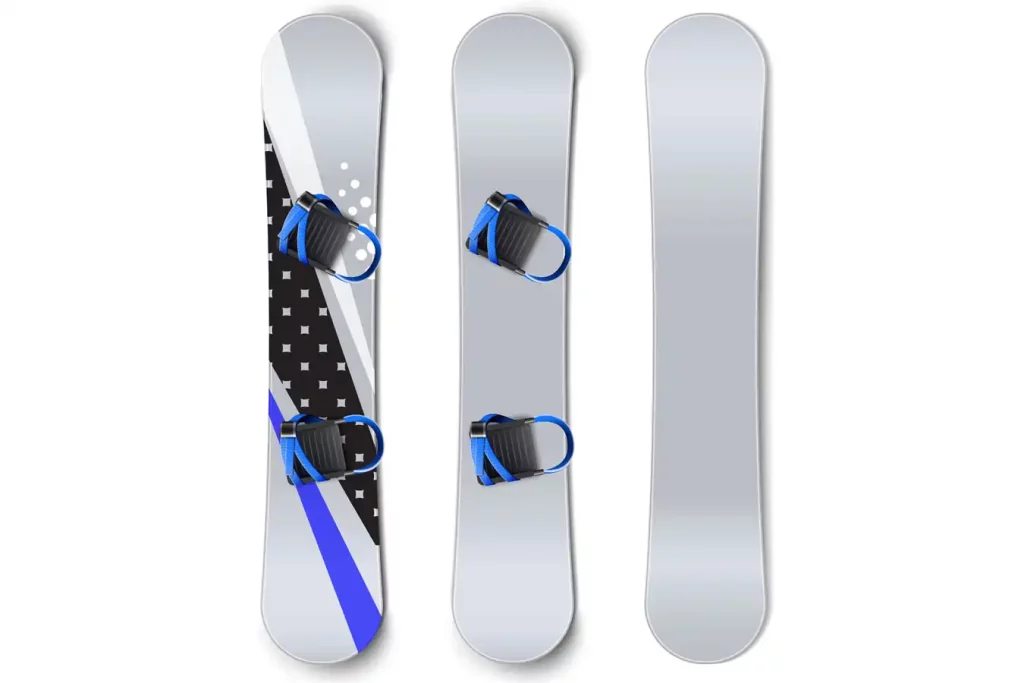“How much does a snowboard weigh?” This is a question that many winter sports enthusiasts often ask.
They understand that the weight of the snowboard plays a significant role in their performance and maneuverability on the snowy slopes.
This is why it’s crucial to understand the factors that influence a snowboard’s weight, and how these can affect your snowboarding experience. So, let’s dive in and explore the world of snowboards.
Understanding Snowboards
Before we delve into the specifics of snowboard weight, let’s gain a better understanding of what makes up a snowboard. The more you know about the different components, the easier it will be to understand how these parts can influence a snowboard’s weight.
The Different Parts of a Snowboard
At first glance, a snowboard might appear as a simple flat board with bindings. But there’s more to it. A snowboard consists of several parts: the top sheet, core, edges, base, and the bindings.
The top sheet is the uppermost layer of the snowboard, often designed with graphic art. This part doesn’t contribute much to the weight, but it’s what makes your snowboard aesthetically pleasing.

The core, usually made from a blend of different woods or foam, is the heart of the snowboard. It largely determines the board’s weight, flexibility, and strength.
The edges are the metal sides of the board that allow for precise control when carving into the snow. The base is the bottom layer of the snowboard that makes contact with the snow. Made from a polyethylene material, it can also affect the snowboard’s weight.
Lastly, the bindings are the devices that secure your feet to the snowboard. They can be made from various materials like plastic, metal, or a combination, each affecting the overall weight.
Types of Snowboards and Their Uses
There are several types of snowboards, including freestyle, freeride, all-mountain, and splitboards, among others. Freestyle snowboards are typically lighter, designed for tricks and jumps in snow parks.
Freeride snowboards, built for off-piste and deep snow, are generally heavier and more robust. All-mountain boards are a hybrid, versatile for various terrains, and their weight can vary widely. Splitboards, designed for backcountry exploration, are typically heavier due to their design complexity.
Materials Used in Snowboard Manufacturing
Snowboards can be made from a variety of materials, which significantly affect their weight. Lightweight woods like poplar and paulownia are commonly used in the cores of premium snowboards. In contrast, cheaper models often use heavier materials like foam or even laminated wood combinations.
Carbon fiber, known for its strength and lightness, is also frequently incorporated into high-end snowboards to reduce weight and increase responsiveness. On the other hand, plastic and steel are used in bindings and edges, respectively, and while they provide durability, they also contribute to the overall weight.
Factors That Influence a Snowboard’s Weight
Let’s now dive into the primary factors that influence the weight of a snowboard. Remember, every ounce can make a difference when you’re gliding down a mountain or launching off a ramp.
The Role of Size in Determining Snowboard Weight
Size plays a vital role in determining a snowboard’s weight. As a rule of thumb, the longer and wider the snowboard, the heavier it will be.
Length is mainly determined by the rider’s weight, height, and style of riding. Riders who prefer fast, aggressive snowboarding on steep terrains often opt for longer, heavier boards for stability. On the other hand, those into freestyle or park riding might choose shorter, lighter boards for better control and maneuverability.
How Material Affects the Weight of a Snowboard
The choice of material is another critical factor that affects a snowboard’s weight. High-end snowboards often use lightweight materials like carbon fiber, combined with lightweight wood cores, to keep the weight to a minimum while ensuring maximum strength and durability.
On the other hand, budget-friendly snowboards often use heavier but cheaper materials like foam or laminated wood in their cores. Similarly, bindings made from heavy-duty plastic or metal can add to the weight, while lighter materials like carbon can reduce it.
The Impact of Design and Features on Weight
The design and features of a snowboard can also impact its weight. A board with many layers or complex design elements will usually be heavier than a minimalist, streamlined one.
Similarly, the inclusion of additional features like wider edges, stomp pads, or intricate binding systems can add weight to the snowboard. Even the type of finish on the top sheet or the base’s structure can add a few extra ounces.
The Average Weight of Snowboards
Knowing the average weight of snowboards can provide a useful benchmark when you’re shopping for your next board. Just remember, “average” can vary widely based on the type of snowboard, its size, and materials used. But let’s break down some average weight ranges by skill level.
Weight Range of Beginner Snowboards
As a new snowboarder, your first board is likely to be on the lighter side, with an average weight of around 5 to 7 lbs. These boards are designed to be user-friendly, easier to maneuver, and less physically demanding. They also tend to be shorter, which reduces the weight.
Weight Range of Intermediate Snowboards
For intermediate snowboarders, the average weight increases slightly, ranging from about 6 to 9 lbs. These boards are usually longer and denser to provide better control and stability at higher speeds, hence the increase in weight.
Weight Range of Advanced Snowboards
Advanced snowboards, designed for experienced riders, can weigh from 7 to 12 lbs. These boards are often feature-packed, with sturdier bindings and premium materials for optimum performance on all types of terrain.
How Brands Can Impact Snowboard Weight
Different brands have different design philosophies and use various materials, which can impact the weight of their snowboards. For instance, brands that focus on freestyle or park boards might prioritize lightweight materials and design simplicity to reduce weight. In contrast, brands specializing in backcountry or freeride boards may opt for heavier, more robust materials to withstand harsher conditions.
The following table provides a general guide on the average weights of snowboards by skill level:
| Skill Level | Average Weight Range |
| Beginner | 5-7 lbs |
| Intermediate | 6-9 lbs |
| Advanced | 7-12 lbs |
In short, a snowboard weigh can range from 5 to 12 lbs, dependent on factors such as the rider’s skill level, the board’s size, design, and materials, with beginner boards typically lighter (5-7 lbs), intermediate boards a bit heavier (6-9 lbs), and advanced boards being the heaviest (7-12 lbs).
Read more: How Should Snow Pants Fit
Why Snowboard Weight Matters
Snowboard weight isn’t just about how much effort it takes to carry your board to the lift. It plays a significant role in how your snowboard performs on the slopes and should be matched to the rider’s body weight and skill level.
How Snowboard Weight Affects Performance
The weight of your snowboard can drastically impact its performance. Lighter boards are typically easier to maneuver and control, making them ideal for freestyle riding and tricks. They also tend to be more responsive, enabling quick directional changes.
On the other hand, heavier boards provide better stability at high speeds and better performance in powder due to their increased momentum. They can also provide smoother rides in choppy conditions, as the extra weight helps to absorb the bumps.
Matching Snowboard Weight to Rider’s Body Weight and Skill Level
Your body weight and skill level should guide your choice of snowboard weight. Heavier riders generally require heavier and longer boards to support their weight and provide sufficient edge hold on the snow. Similarly, advanced riders often opt for heavier boards for their stability at high speeds and robustness for aggressive riding.
Lighter or less experienced riders, however, will likely find lighter boards more comfortable and easier to control, as they require less physical strength to maneuver.
Snowboard Weight and Transport: What to Consider
When it comes to transporting your snowboard, weight becomes a crucial factor. Lighter boards are easier to carry around, both on and off the slopes. They’re also less likely to incur excess baggage fees when traveling by air. So, when choosing a snowboard, consider how and where you’ll be using it. If you’re a globe-trotting adventurer or often hike to off-piste areas, a lighter board might be your best friend.
Choosing the Right Snowboard Weight for Your Needs
When selecting a snowboard, finding the right weight is crucial. A snowboard that’s too light or too heavy can hinder your performance and overall enjoyment on the slopes. But don’t worry—we’ve got some recommendations to help guide your decision.
Snowboard Weight for Beginners
If you’re just starting out on your snowboarding journey, a lighter board can be a good choice. A lighter board, typically within the 5 to 7 lbs range, can make learning basic techniques easier. Why? Well, lighter boards are generally easier to maneuver and control, which can make your initial experience less daunting and more fun.
But remember, while weight is important, it’s not the only factor to consider. The length, width, flexibility, and shape of the snowboard also contribute significantly to its ease of use. As a beginner, you’ll probably want to opt for a shorter, softer board with a forgiving shape.
Snowboard Weight for Intermediate and Advanced Snowboarders
For intermediate and advanced snowboarders, the weight of the snowboard becomes more of a personal preference, largely based on your riding style.
If you’re into freestyle or park riding, a lighter board (generally within the 6 to 8 lbs range) can be beneficial. Lighter boards are typically more maneuverable and responsive, making them ideal for tricks, jumps, and quick turns.
If you prefer high-speed carving, off-piste, or backcountry riding, you may prefer a heavier board (around 7 to 12 lbs). Heavier boards tend to be more stable at high speeds and provide better performance in powder due to their increased momentum.
Read more: How Much Should a Backpacking Tent Weigh
FAQ: Common Questions About Snowboard Weights
How do you pack and ship a snowboard?
How do you distribute weight on a snowboard?
What does W mean in snowboard size?
How do I know my snowboard size?
Final Thoughts
There you have it—the lowdown on snowboard weight. The question, “how much does a snowboard weigh?” might seem simple, but as we’ve discovered, the answer is quite complex.
The weight of the snowboard plays a critical role in how it performs, and it’s essential to match it to your body weight and skill level. While lighter boards offer easy maneuverability and control, making them ideal for beginners and freestyle riders, heavier boards provide stability at high speeds and smoother rides in rough conditions, suiting experienced riders or those who prefer off-piste.
Remember, choosing the right snowboard is a personal decision, and weight is just one factor to consider. As with all equipment, the best way to find the perfect fit is to try out different options. So, don’t be afraid to experiment with different boards until you find one that feels just right under your feet. After all, the ultimate goal is to have fun and enjoy your time on the slopes. Happy snowboarding!


